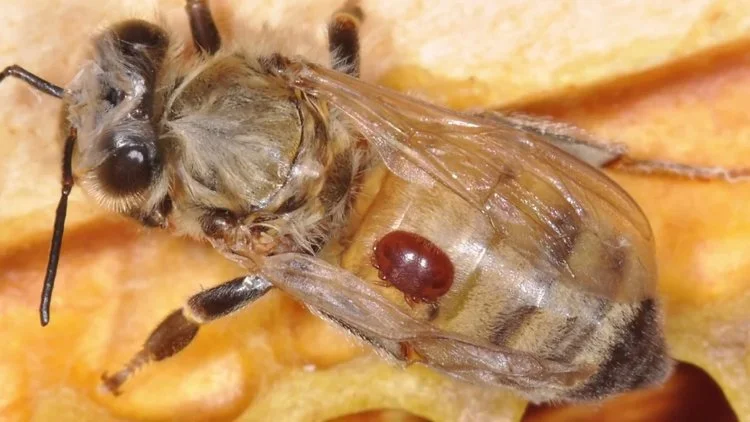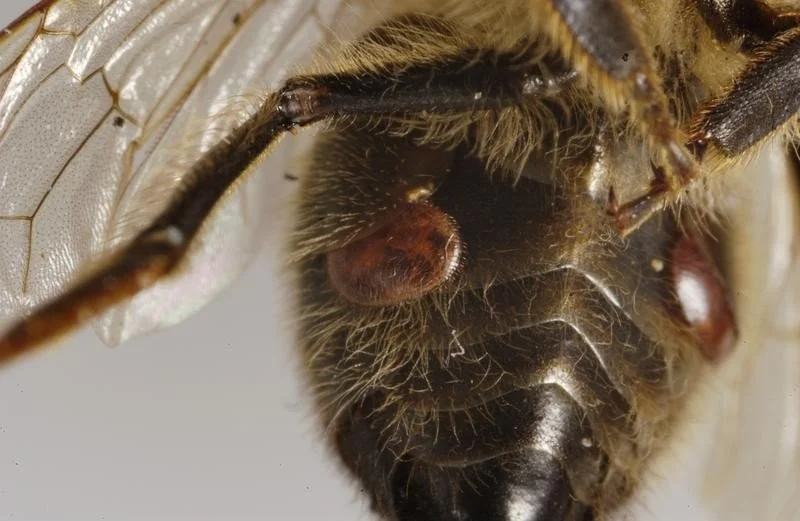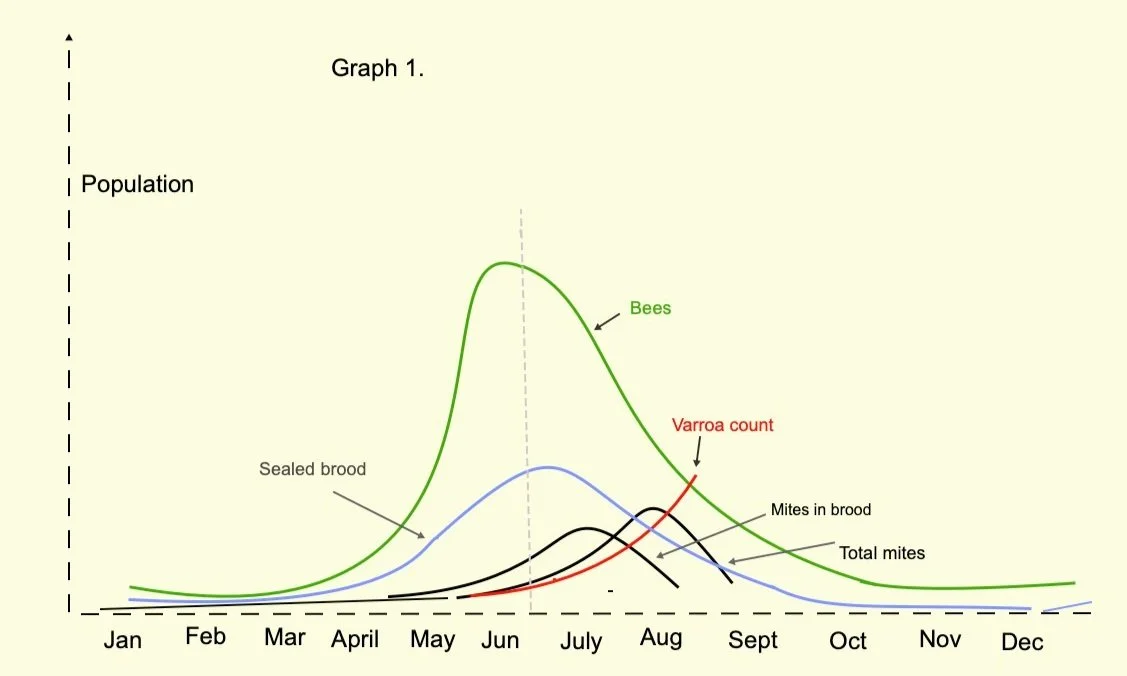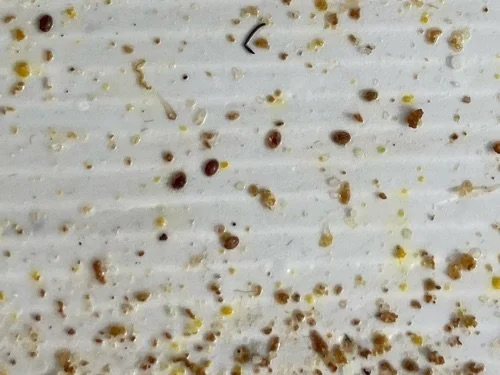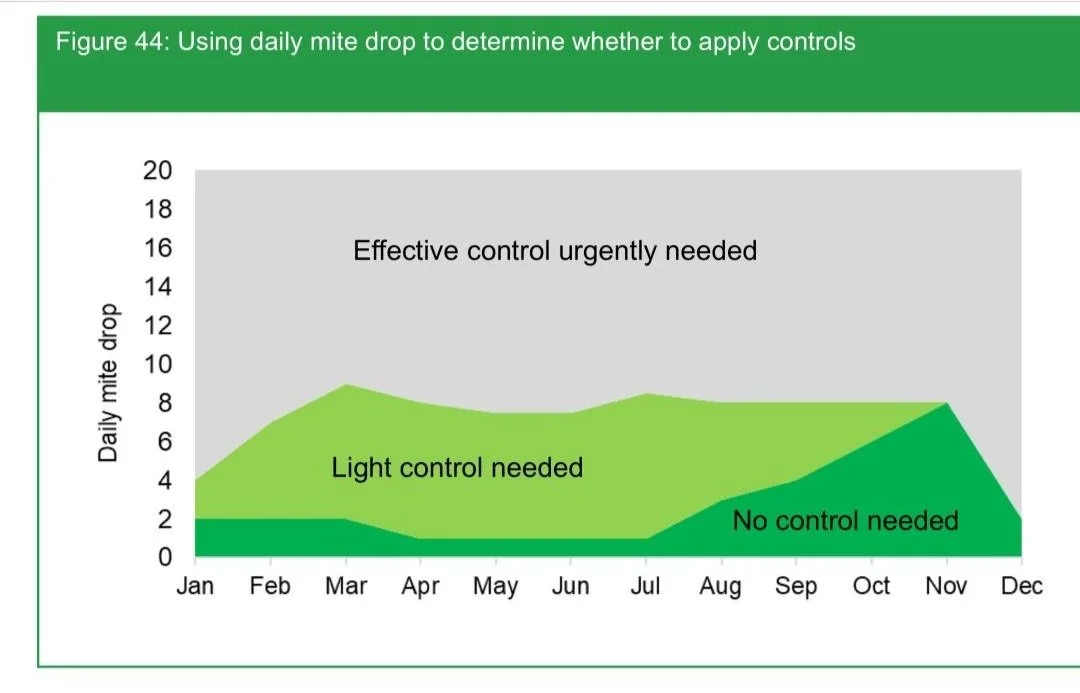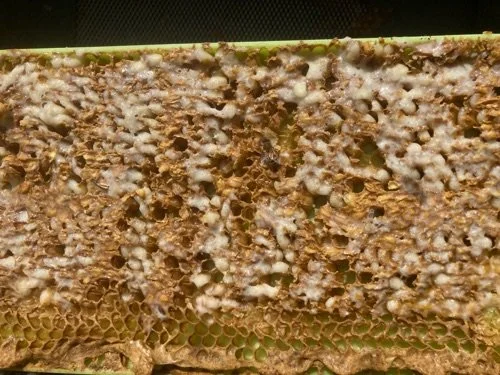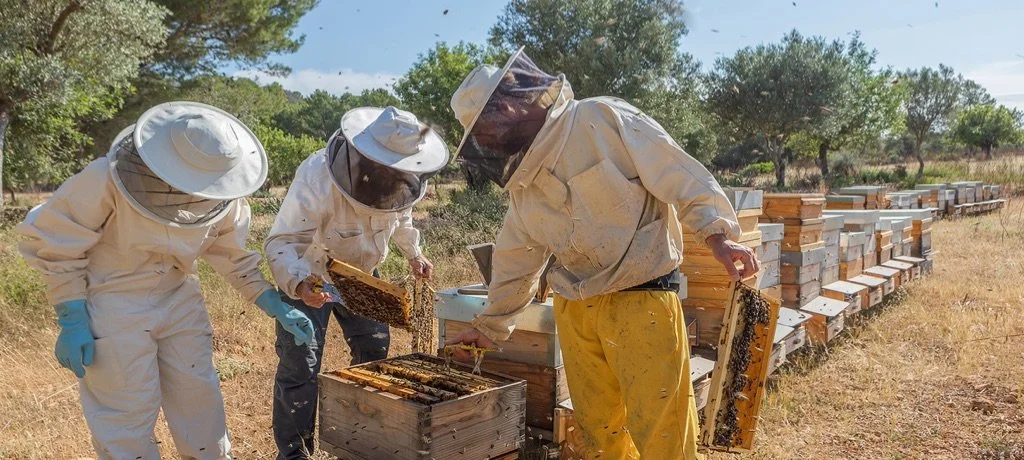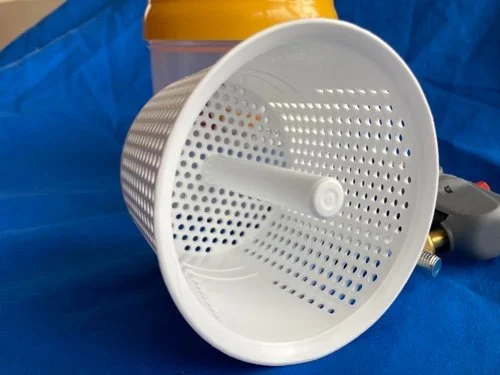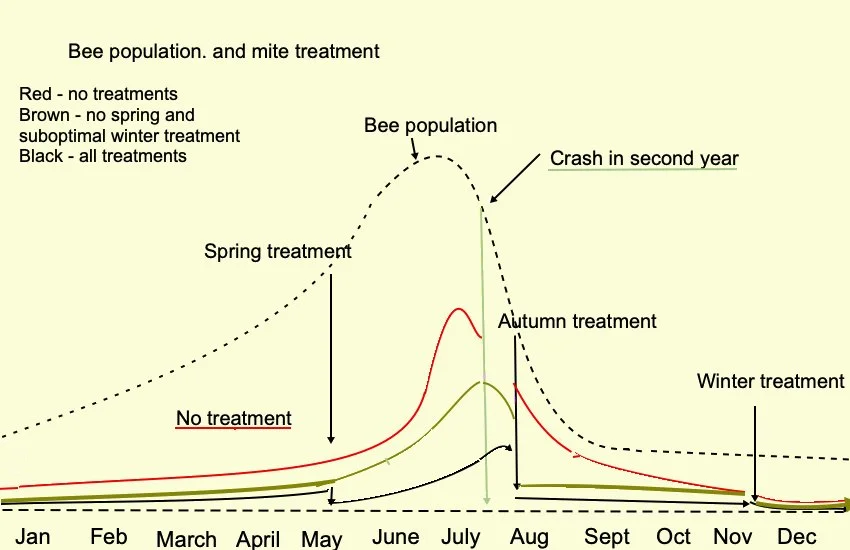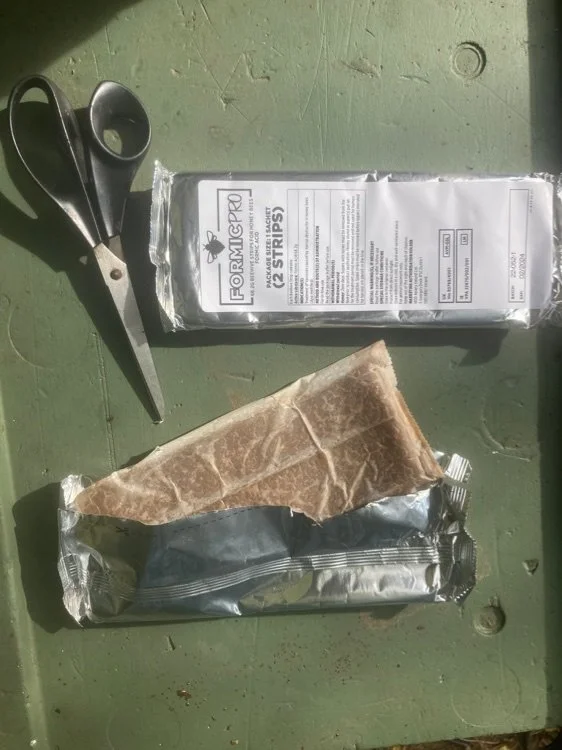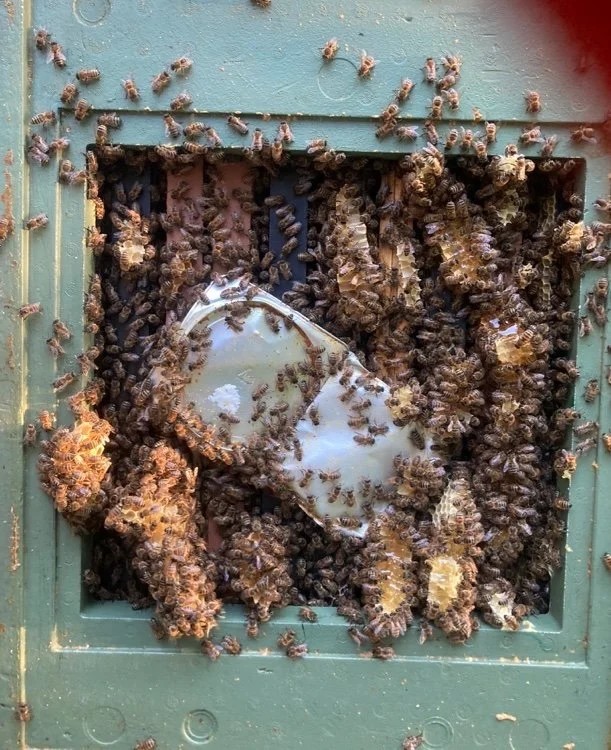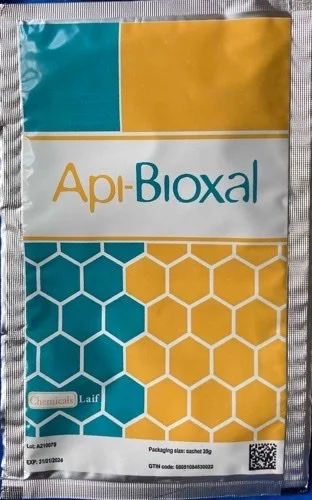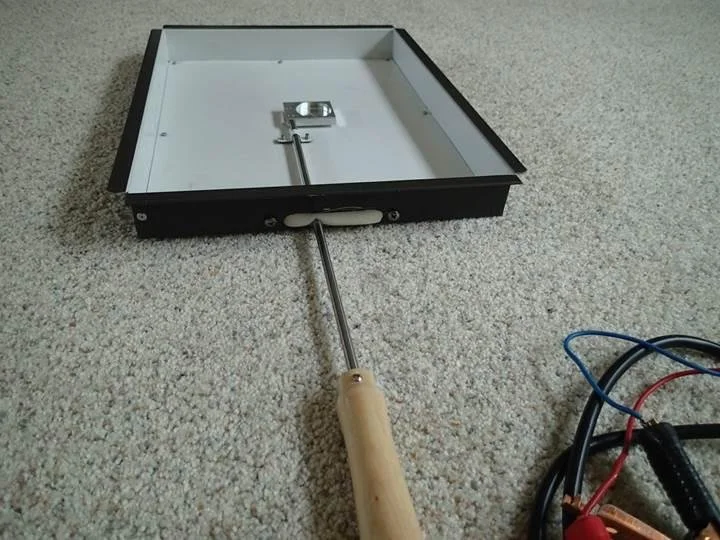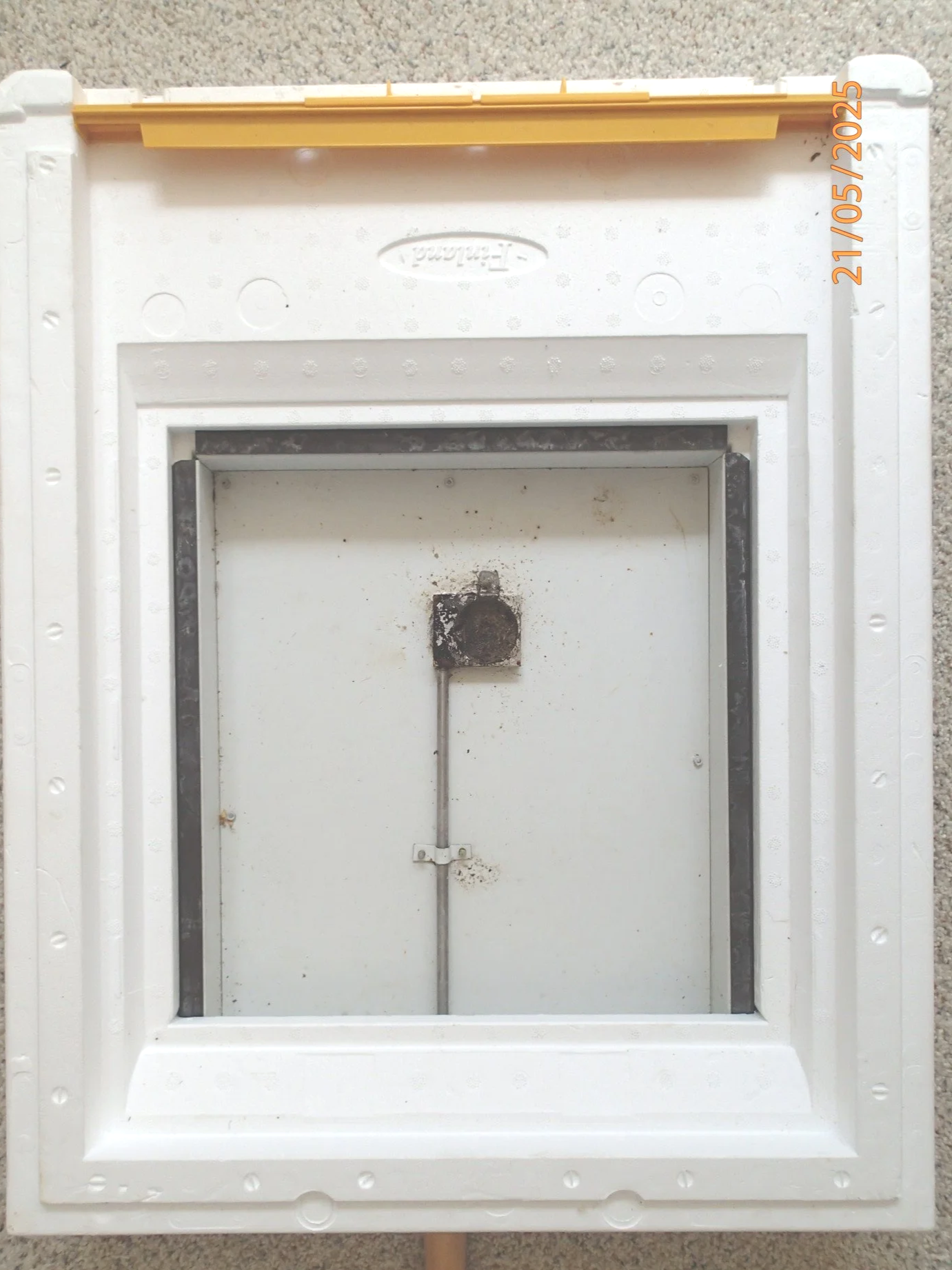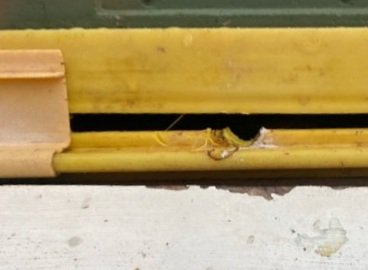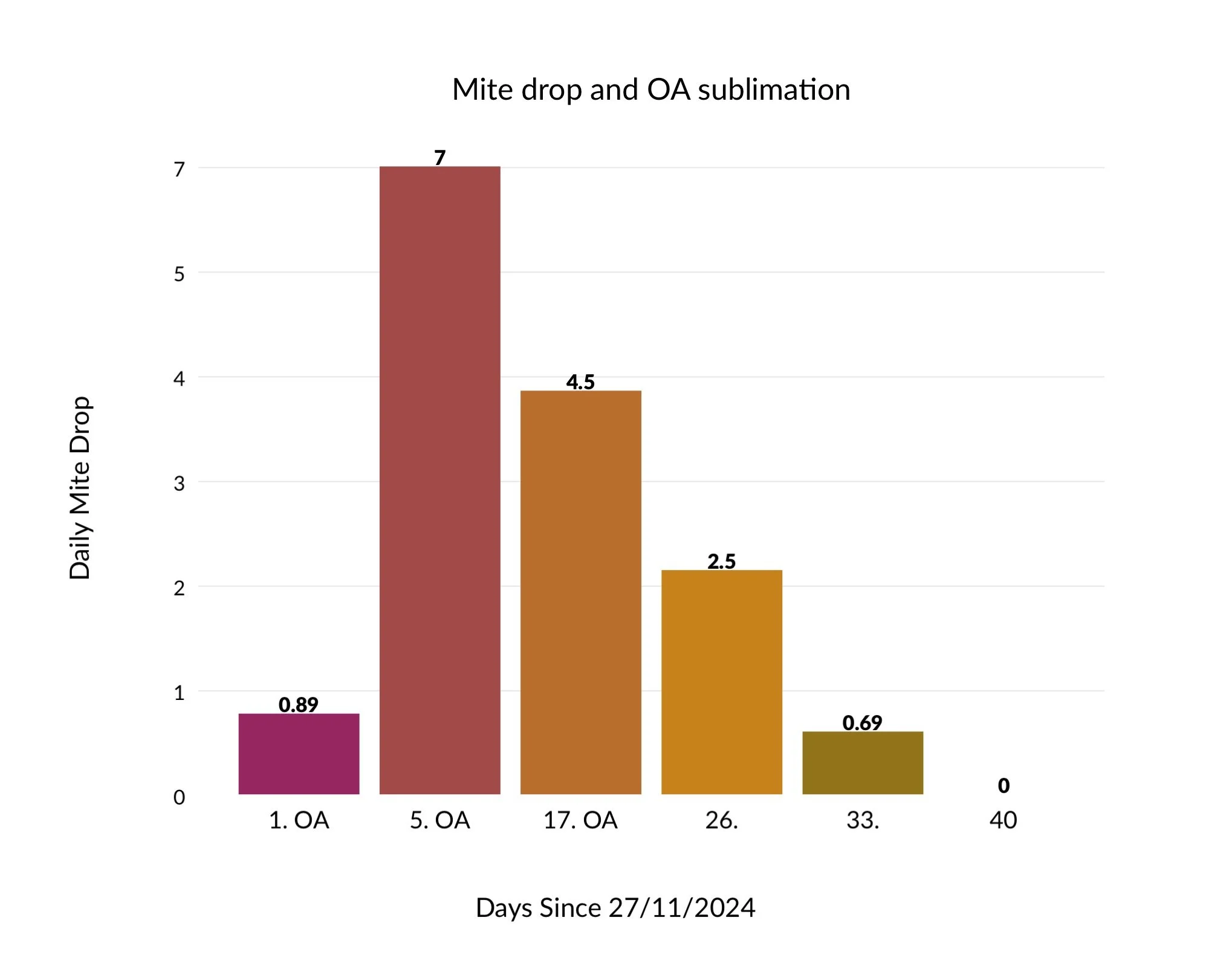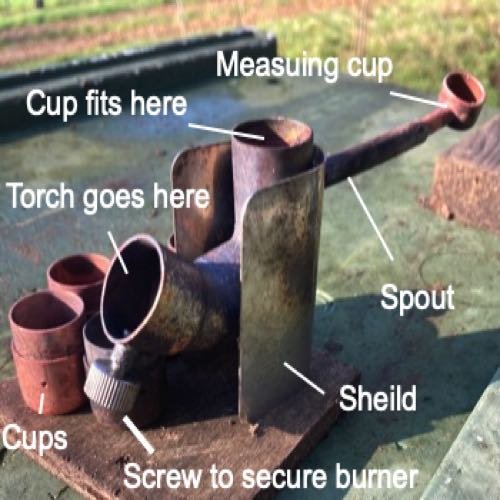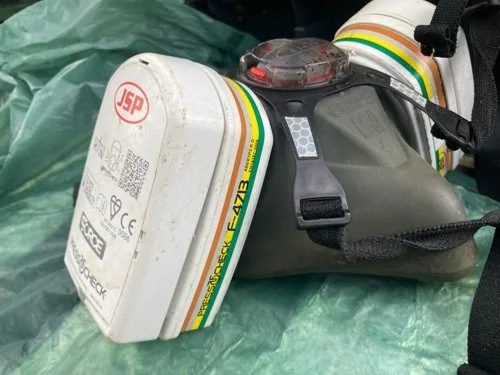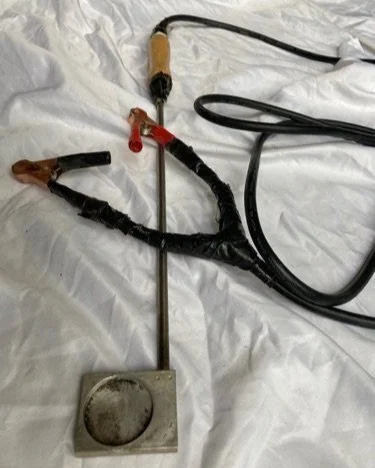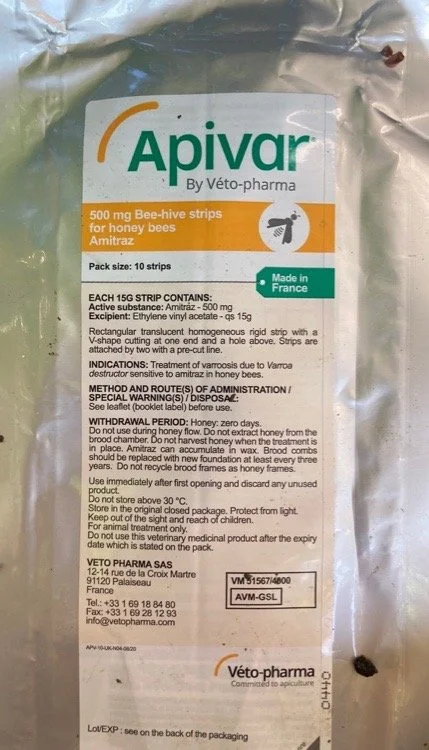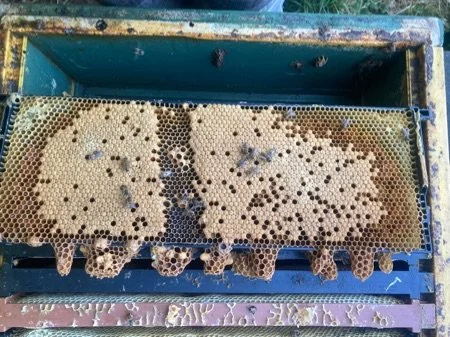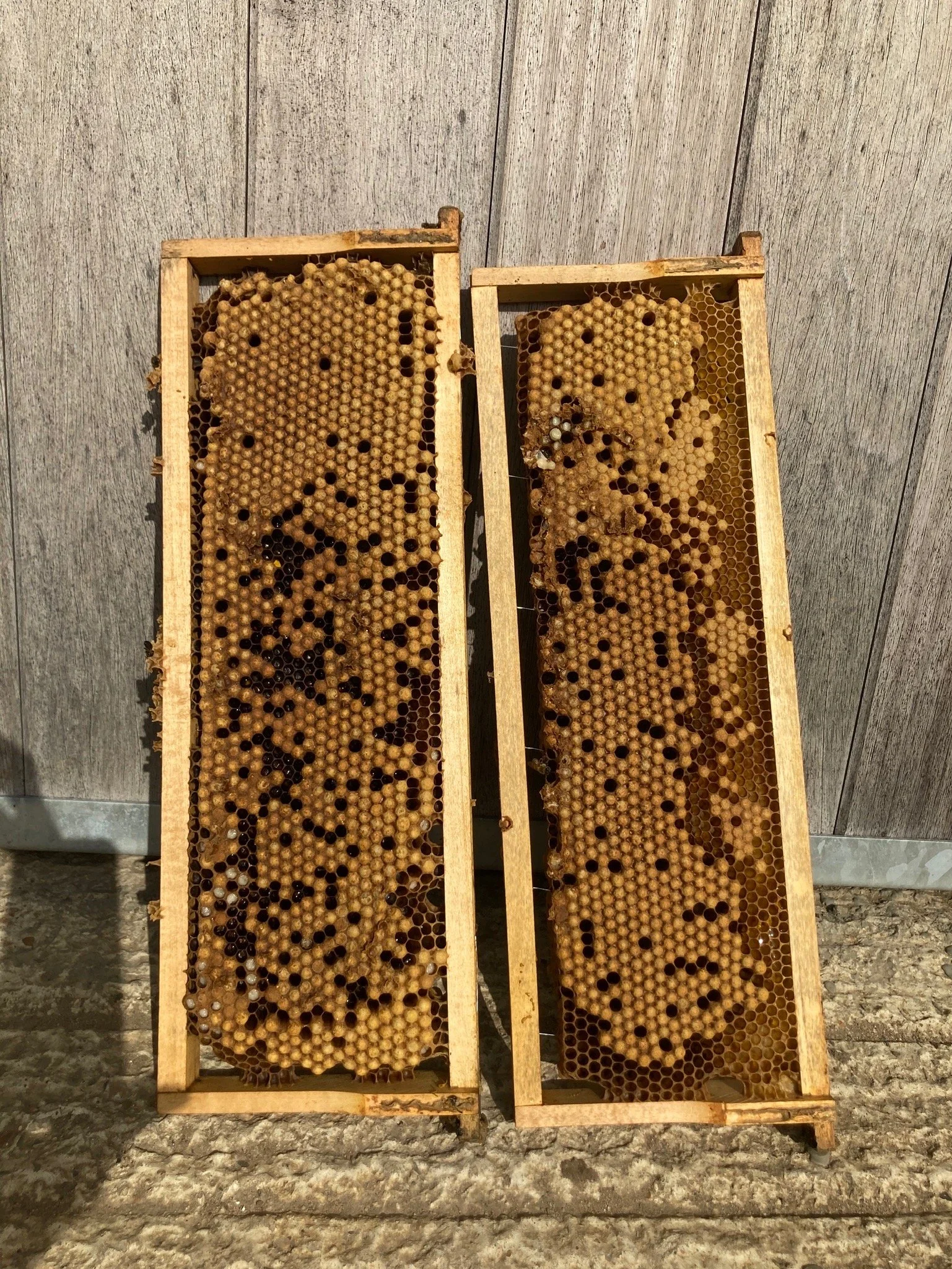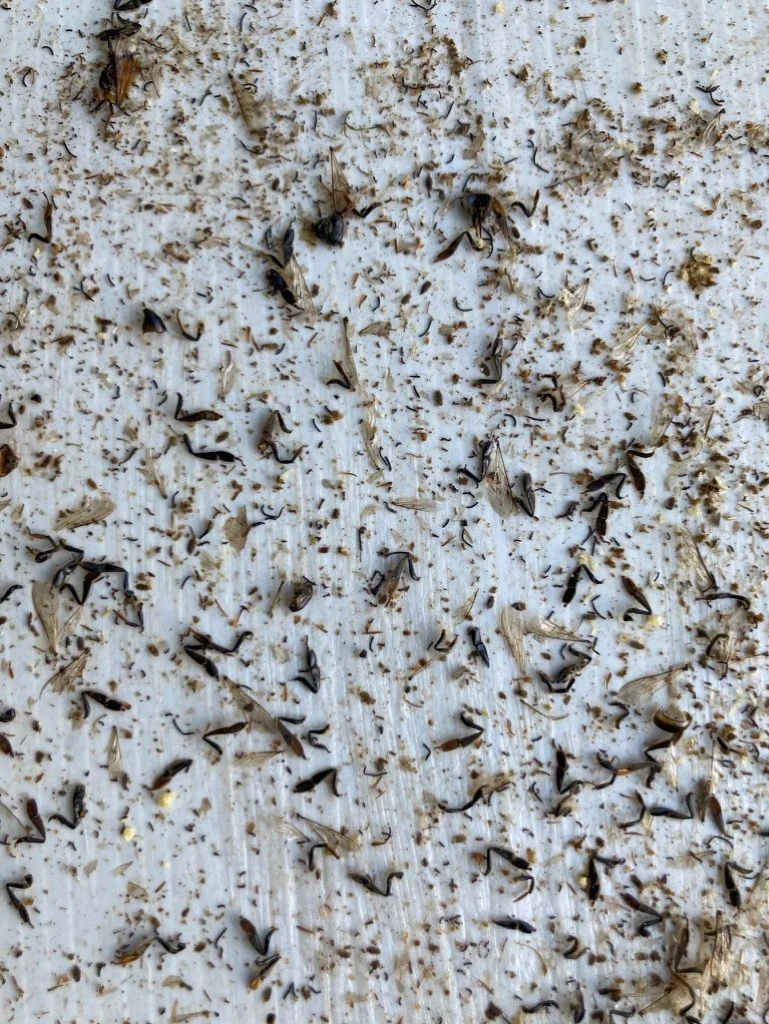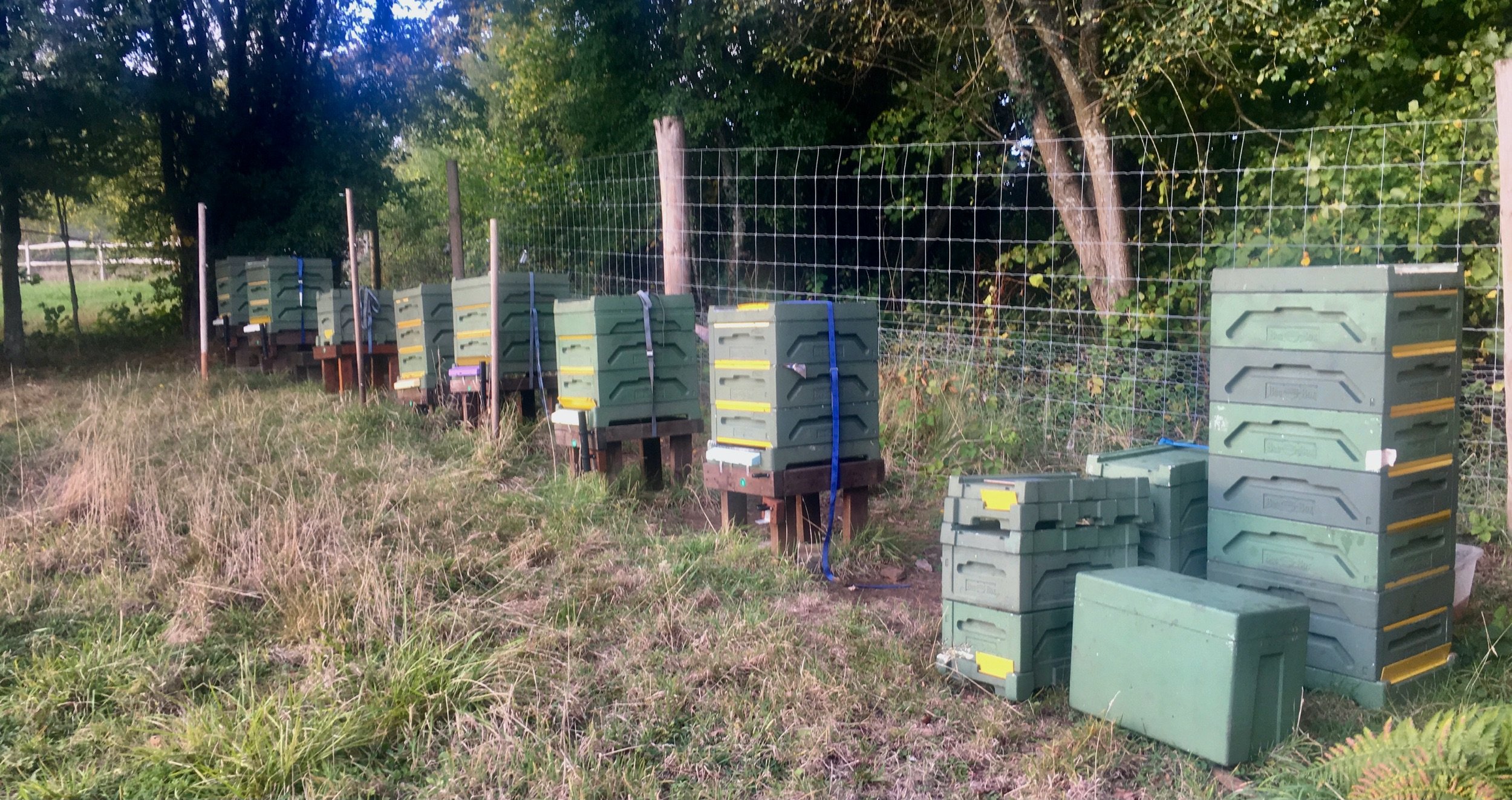
Varroa destructor
A deadly parasitic mite
40 minute read
Basic Assessment: Be able to identify and describe varroa mites, describe methods for detecting and monitoring the presence of varroa and describe its effect on the colony, including awareness of the effect of associated viruses.
History
The varroa mite is an invasive species. Its home range is Asia, where it lives in the nests of a small bee called Apis Cerana. Varroa and these bees tolerate each other.
However, most Western Honey bees (living around Europe) have no resistance to varroa. In 1992, the mite became established in England. It spread so rapidly that it caught many beekeepers off guard. Many lost all their bees and quit beekeeping altogether. The mite has proven impossible to eradicate, and except for a few remote places it has spread worldwide. Thankfully, annual treatments keep it in check.
@ ucncbeekeepers.org
Varroa on the abdomen of a young bee.
Appearance: There are two species: Varroa jacobsoni and destructor. They have much the same appearance and effect, but destructor is more virulent. They are 1–1.8 mm long and 1.1–2 mm wide, depending on their maturity, and their eggs are 0.5mm long. They have eight legs and are reddish brown and shaped like scallop shells. Males are smaller and yellow-white. Immature females are pink. Varroa are related to the scabies mite, not crabs (even the pubic variety).
Here’s a diagram illustrating their lifecycle.
Mite Biology
Life cycle: To treat varroa effectively, it is crucial to appreciate the tempo of their lives. The mite has two life stages: reproductive and dispersal (ectoparasitic).
Reproductive stage
The foundress (mother) crawls into a brood cell just before it is capped. She hides in the brood food before the cell is sealed. She and has a built-in snorkel so she can breathe. Once the cell is capped she makes a hole in the pupa so that she can feed, and 60 to 70 hours later, she lays a male egg and then a female egg every 30 hours. These hatch after 6–7 days. The young mites commit incest, but if 2 or 3 foundresses enter the cell simultaneously, as sometimes happens when there is little brood, the males compete for the girls. Their joy is short-lived because they die once the bee emerges. In the winter, varroa mites feed on adult bees for several months because there is little brood. The main problem with the mites is that they inoculate pupae with large amounts of viruses - Paralytic and Deformed wing viruses. These damage all aspects of a bee’s life: immunity, foraging, ageing, and cause small-sized bees. Drones carry fewer sperm.
Varroa mites on a honeybee pupa © Crown copyright
Before varroa, viruses like Deformed Wing Virus. (DWV) were present in colonies, but at such low levels that they did no harm. By the time deformed wings are visible, the viral load is high, as only 1 in 100 bees infected with DWV shows any abnormality.
So, bees can look healthy (albeit some look small) when they are seriously unwell.
They elicit non-specific signs such as lethargy and reduced foraging and supersedure. Once the DWV levels and other viruses are high, the colony sickens and is more likely to die in the winter. Eventually, the colony shows signs of being seriously unwell and is said to have Parasitic mite syndrome (PMS), formerly known as Varoosis.
Drones and Varroa
The mite preferentially breeds in drone brood so that infestation levels are eight times higher than worker brood. Drones parasitised by varroa do not survive the two-week maturation period. Because of this, the surviving drones are the least affected and carry the least Deformed Wing Virus (DWV). The exception is that some have it in their endophallus and transmit the virus when they mate, thereby causing early queen failure.
Breeding success is not as good as one might expect. Usually, one would expect a foundress (mother) in a worker cell to produce one, occasionally two mites and drones 2.2–2.6 mites per cycle. Varroa population growth happens despite some foundress being unproductive, slow to start laying or surviving one reproductive cycle rather than three. When a bee emerges, only the mature mites survive; the male and immature females die. However, the number of mites increases dramatically.
Ectoparasitic stage
Until recently, people thought the mites attached to the bees without feeding on them. The scientific term for this is phoretic. But now we know that mites feast on the bee’s fat and blood as exterior parasites.
After emerging from their brood cell, mites soon move to other bees; usually nursery bees and stay on them for at least five days. As the varroa infestation grows unchecked, they attach themselves to foragers and infest other colonies.
During the ectoparasitic stage varroa attach themselves to the ventral surface of bees.© Crown copyright
Gaph 1. illustrates how the mite population varies through the year. The graph is not to scale.
The number of mites in the brood rises slowly until drone production in May.
Researchers are puzzled about the purpose of the ectoparasitic phase. One would think it would improve reproductive success. But in terms of DMV, the length of the phase affects varroa fitness - Mites with a prolonged ectoparasitic phase become infected with more DWV. Subsequently, the host pupae receive a larger dose. This is corroborated by the finding that the longer the ectoparasitic phase, the greater the abnormalities in newly emerged bees. Moreover, the mite's life is significantly shortened if the more virulent DWV-B is the chief strain.
To learn more: Varroa and its lifecycle.
Parasitic Mite Syndrome (PMS)
PMS comes like a thief at night, even when varroa is monitored. This is due to the mite reproduction dynamics; particularly when the colony is expanding.
The comb may look spotty because nursery bees remove affected pupae. Supersedure often occurs when levels are high. Should it be successful, the new queen may briefly improve matters as she lays with gusto; more likely, requeening fails. Bees, firstly in nucs and then in hives, become listless, reduce and eventually stop foraging. Finally, the problem becomes evident as bees die in the middle of emerging and many have deformed wings. A colony can pass from looking healthy to dead within several weeks. Since bees drift, it is prudent to treat all your colonies at the same time.
Be careful which treatment to use: Formic Pro and MAQS kill unsealed brood and can only be given to strong colonies. Apiguard is not terribly effective, leaving Apivar/Amitraz (or oxalic acid if broodless). If the colony is still strong with no symptoms, a shook swarm using drawn comb is appropriate.
Feed affected colonies with sugar syrup. If they fail to take it, they are doomed.
After treatment, wait at least two weeks before checking that they are queenright. They should be foraging and have unsealed brood. Pollen may be going in.
Two bees with deformed wings © Crown copyright
PMS: Many bees die as they emerge. Some cappings are perforated due to bees inspecting the cell contents. Four weeks previously, the natural mite drop was two per day. The colony did not have a spring treatment but underwent three consecutive Demaree manipulations. Following varroa treatment, the colony bounced back strongly.
In this colony collapse is inevitable. Most of the bees have deformed wings, and there is some Sac brood. ©scientificbeekeeping.com
How to check varroa levels
Mite drop
Drone sampling
Rolls — sugar, ethyl alcohol, detergent. Varroa fall off their bee host when mixed with these substances.
Sugar dusting Mites fall through the hive mesh floor after the top of the frames have been generously dusted with finely ground sugar.
Mite drop after Oxalic acid sublimation.
Natural Mite drop
The floors of most hives are open apart from a steel mesh/screen/cloth, called an Open Mesh floor (OMF). As the bees rub against each other and preen, some mites become dislodged and fall through. To assess the severity of the infestation, a board generously sprayed with cooking oil or brushed with petroleum jelly is put under the OMF. Count the varroa drop rate after leaving the sheet in position for at least seven days. The reason for 7 rather than 3–5 days is due to the natural variability in mite drop. Counting the mites on the board after OA sublimation should be more accurate. In PMS, the count is unreliable.
Mite drop
In scientific parlance, mite drop is a sensitive test but prone to significant false negative results.
The natural varroa drop test depends on three assumptions:
You can see the mites.
Mite drop is correlated with the number of mites on the bees. The correlation is awful when there is sealed brood; Wally Shaw established this unquestionably.
When there is almost nil or no brood, there is a good correlation between the number of mites on the bees and the total number in the colony
Crud under the cluster can make it impossible to count Varroa.
Estimating the number of mites in a colony using mite drop (NBU)
November to February: Multiply by 400
May to August: Multiply by 30
March, April, September and October: Multiply by 100
In the active season keep the count below 1000.
Examples of mite drop. The board that looks as if it is covered with salt and pepper has a high count. It represents a colony that could be at the point of collapse.
Lower photo. If only this number of varroa (7) shows up on a Varroa board every day, the infestation could feel small. The drop is due to treatment. It represents almost all the mites in a strong colony with negligible sealed brood. Still, the infestation must be approaching 1500, so the lingering effect of viruses could affect winter survival. A first treatment (Apiguard) had no effect, so I gave a second treatment (Formic Pro). The colony was strong in the spring, with a low varroa drop rate. But it rose again by May and required further treatment.
But if 90% of the mites are in sealed brood, and 20% of the ectoparasitic mites fall onto the varroa board: 9 × 5 × 7 = 315 mites in the colony. My maths simplifies the situation, but the colony will have a serious mite infestation in two months. Using NBU guidance, assuming the test was done in February: 7 × 400 = 2800 so the colony should be dead! A few beekeepers recommended a rate of 10 mites/day as a cut-off. Don’t believe them!
Fig. 44 @nationalbeeunit.com
Factors that influence results
The amount of sealed brood and whether the colony is expanding or contracting.
The amount of drone brood.
The size of the colony
The length of the brood-rearing season
Mesh only covers part of the floor e.g., half of a BeeBox Langstroth floor. That’s okay with this subjective test — Rusty Berluw.
Recent mite treatment; check the treatment was successful. Amitraz or a thymol-based treatment - I don’t know precisely. Probably four weeks after sublimated oxalic acid.
The time of year. For example, in the spring, when the colony is expanding rapidly. After a spring treatment, repeat measurements at least twice in the summer.
Many people do things differently and use precise mite drop measurements. In the past, the NBU provided a Varroa calculator. But I can find no trace on their site, which is good really as it added an air of respectability to a misleading test.
The timing of varroa treatment.
The position of the cluster in the hive.
Air temperature —timing of spring expansion.
Although it is unreliable, many people use mite drop and their bees do fine. So, if you don’t want to know about other methods, skip to treatments.
Drone sampling
Sample drone brood at the purple-eyed stage using an uncapping fork. I’ve heard that day 15 is the purple eye stage. When I listened to this, it seemed too early. Then I realised it was counted from day 4. So, it would be more consistent to call it day 19. I’ve not worked out a way to ensure I catch the brood at this stage. One sampling technique is to push the fork under the cappings and use the end of the needles as a hinge whilst you lever the drone pupae up.
Unless the queen laid up the whole frame at once, expect some larval mush, so it is not a job for the squeamish. Achieving a reliable result depends on how much brood is in the hive. As a rule of thumb, use a sample of at least 100 drones. Two mites per hundred are significant in the spring; higher results are reasonable in the summer. I suggest you do a better test If you detect 2/100.
The first picture shows two varroa on pupae. Sampling one side of a frame detected 11 varroa. The colony had PMS.
The second photo shows drone mush. I doubt the manipulation was effective.
The Rolls (Royce of tests)
Know your enemy © Crown copyright
“Rolls” remove the second source of inaccuracy (refer to the green box above) and are the gold standard tests. All the mites are detached from a standardised sample. A sugar roll doesn’t kill them and is almost as reliable. The third issue remains, but is not insurmountable.
Sugar Roll
A sample of bees is shaken up with finely ground sugar.
Equipment
A one-litre food preserve/mason jar with original lid and 3-4 mm wire mesh/screen lid.
funnel for preserves helps but is not essential
American-style half-cup measure
White or cream washing up bowl
Water sprayer
Kitchen-style paper towel
icing or finely ground white sugar
If you trawl the internet, there are many ways to perform and interpret the result. Randy Oliver, scientificbeekeeping.com, has scientifically evaluated a method, so I recommend you do it his way. It detects up to 95% of mites.
Unfortunately, a sugar roll occasionally detects 50% of mites compared with an ether roll.
Calibration
The first step is to calibrate your sample. Find the queen and put her somewhere safe. Scoop up an American half cup of bees (118ml), put them in your jar and use windscreen de-icing or WD40 spray to kill them.
Once all the bees are dead, tip them onto a white sheet and count them. You should have 300 (plus or minus 25). Someone says 1/4 cup contains 200 bees, so someone can’t count.
The Randy Oliver Method
Put the queen somewhere safe.
Collect your sample by running a cup up a brood frame. It is not as easy as it sounds. So, brush a lot into a jar using a brush and a large funnel. Easier is to shake frames of young bees into a washing-up bowl and test those too young to fly. A sample from the supers gives a 20% lower result.
Put the sample of bees in the jar with the mesh as a lid; pour in one tablespoon of finely ground sugar (you could use refined icing sugar if you only have a couple of colonies). Use enough to coat the bees. Use 2 tbs if the bees are sticky with nectar. The anti-caking agent in icing sugar will not harm the bees.
Replace the lid.
Shake vigorously for 1 minute. If you don’t fancy being so energetic, roll the bees around for 2–3 minutes, but the result may not be reliable.
Leave it for one minute to rest.
Replace the lid with wire mesh.
Then, shake to remove the mites from the bees. Do this for one minute over a sheet of kitchen towel.
Finally, spray some water on the paper towel; the sugar melts away.
More than two mites per 100 bees, and you have exceeded the treatment threshold.
The bees survive at least 24 hours afterwards. Sacrificing a few bees for the sake of the colony isn’t so bad.
Using sugar like this is a faff. For example, I carry my stuff, the bowl only just squeezes into my rucksack. I’m ready, but I discover I need a pestle and mortar to tackle lumpy sugar.
The third cause of inaccuracy (of determining mite infestation) requires estimating the amount of sealed brood in the colony, the drone, and worker brood infestation rate, and the number of emerged bees. I have not done it, but it would be interesting.
Isopropyl Alcohol wash
Use 91% rather than 70%. I’ve read that some people use it diluted 1:4 of water. Most of the mites fall off in the first 5 seconds. After this, agitate/roll it slightly for 30 seconds (to dislodge those stuck in the raft of dead bees).
Video — doing an alcohol wash using Randy’s cup
Detergent wash
We know this works with the correct detergent, Dawn Ultra (available on Amazon). It may not work with others. Use two tablespoons per gallon. Done correctly, the sensitivity can be as good as alcohol. Randy suggests:
For best results, allow the bees to sit in the detergent solution for a minute or two before agitation — most of the mites will have by then dropped to the bottom of their own accord. Then agitate by swirling, not shaking. To avoid peering through the bubbles to count mites, use a 10x magnifying mirror (6-inch diameter) placed about 4 inches below the bottom of the cup. Remove the bees above the mites, so that you are looking up at a white background (the sky through the solution.)
Sugar dusting
Use a varroa board not coated with sticky petroleum jelly or oil. Shake a cupful of finely ground sugar evenly over the frames through a screened board like a propolis board so that the bees do not fly up. Wait 10 minutes, and then count the mites. A 10-mite drop is significant. The varroa board is a tight fit in a BeeBox, which makes this test problematic.
EasyCheck and CO2 Narcosis
Research indicates that concentrated CO2 harms queens. After 1–2 minutes, whether naturally mated or inseminated, queens are 10 mg lighter (Harbo 1986). Longer term, inseminated queens that undergo narcosis lay adequately in their first year but less so in their second. If virgin queens are exposed, they orientate poorly. Paradoxically, queens who are gassed twice, lay eggs sooner than those that aren't (not all studies concur). Narcosis reduces workers' foraging and longevity.
It seems obvious that CO2 narcosis is in no way an anaesthetic, but acts by causing sufficient hypoxia to result in tissue damage. Under natural conditions, bees tolerate concentrations of 1% before it stimulates them to fan; they aren't CO2 wimps.
So what to do?
I can not make firm recommendations. Varroa drop rate may be a bad test, but most people rely on it. Repeat it and see if your results are consistent. When your colonies are chugging along nicely, you could do a roll. The problem with a sugar roll is that it is a bother, a fiddle. You could use alcohol, but most people prefer to drink their vodka rather than give it to their bees.
Timing is Important.
Autumn - treat immediately after harvest in early to the middle of August, no later. This timing is important as winter bees need to be healthy.
Winter - when broodless - mid-November & December
Spring - As soon as you find that the levels are high or use it routinely
Summer - if necessary
Varroa levels need to be checked pre and post-treatment. For example, a pre-treatment infestation of 100 compared with a low infestation of 10 treated with a method that has a 90% success rate results in 10 versus one mite residual infestation. So, for example, if varroa levels are high after six weeks of treatment with Apivar, it would be sensible to extend the treatment.
A winter treatment with Oxalic acid in a broodless period has a 97% efficacy. However, it is difficult to know when a colony is broodless.
I urge you check mite levels in the spring. At this time of year the colony is rapidly expanding so the natural drop rate may be misleading. I think it is safer to do a spring treatment regardless; If you do not want to use a chemical treatment, at least do Drone trapping.
Inducing a broodless state by destroying sealed brood in the winter. This involves looking at the varroa (screened) board to determine the site of the brood, opening the hive, and lifting a few frames. The Laboratory of Apiculture and Social Insects at Sussex University has successfully used this approach. With plastic frames, it is possible to remove the brood down to the midrib. Wax foundation is more tricky as the brood can only be squashed, and the mites may survive. Indeed, someone in my association using wax foundation was nonchalant about the process, but disappointed by the result.
A friend helped me perform brood destruction on three colonies in poly hives on an overcast day at 12 °C in December. All the colonies were on two brood boxes and all of them were full of bees, similar to a summer population, and not in the slightest clustered. Smoke did not pacify them because their stores were sealed. I have never experienced such irate bees. They plastered the back of my suit.
The positioning of debris on the varroa in a colony predicts when it is clustered. (pretty obvious really). In a Beebox bees usually cluster against one wall at the front of a hive. At 12 °C maybe less, the bees walk around the whole of the hive so varroa are evenly distributed over the board. Opening the hive makes it easy to assess stores, not that I recommend it!
Don’t let me put you off. Your circumstances are probably different from mine. In a wooden hive with a circumscribed brood nest and smaller bee population, it could work fine. Withdraw if they get upset. Perhaps the brood could be rapidly removed by cutting all the way through the foundation? A torch is handy, as it is possible to spot sealed brood without removing all the frames. Breaking up the cluster is not without risk.
Projected varroa population growth in drone and worker brood
Varroa mite opulation growth starting out with 30 mites in the colony In January
Growth starting out with 100 mites in the colony In January. Theoretically the mite load in August would be 4400.
Varroa mite growth starting out with 30 mites in the colony In January with no drone brood all year long.
These simulations assume mite reproduction in worker brood as 1.2, and 2.2 in drone brood, with each mite surviving three brood cycles, and a five day phoretic period. I have assumed that after May, 20% of the mites replicate in worker brood and the rest in drone brood. Confounding factors include the variability of the ectoparasitic period and the mite reproduction rate. Many people reckon that it takes 2–3 years before a colony dies. I’m surprised, perhaps they mean what happens with inadequate rather than no treatment, or bees with some varroa resistance.
The conclusion is clear; drone brood is enemy number one. Start the year with a low mite count. If a colony is treated when it has a large infestation, the level will be high at the end of treatment, e.g. 85% efficacy with a total infestation of 1000, the infestation will be reduced to 150 mites.
Varroa Treatments
MAQS / Formic Pro: treatment takes one week. Unfortunately, queens occasionally die. It is the only treatment that may be used with when supers are on the hive. If you need to treat varroa in the summer, but the colonies are too small, remove one queen and put her with some young bees in a little nuc. Unite the colonies and treat. If you wish, revert to two colonies and return the queen in an introduction cage. These treatments are up to 97% effective, i.e. any result less than 98%. Randy Oliver recorded it as 77%. Occasionally, I have experienced poor results. However, these are the only treatments that used to be given with supers on the hive. There is an edict that no treatments should be used with supers on the hive because honey is a food product. Following this reasoning, the use of wax foundation, that is invariably contaminated, should be banned.
Oxalic acid (OA): trickling this in a sugar solution is toxic to brood but easy to administer compared to standard sublimation devices (devices that heat the crystals until they vaporise to form smoke). Marginal benefit may result from repeated sublimations outside a broodless period.
Amitraz: = Apivar strips (fumigation tablets are used in other countries). The duration of treatment is six to ten weeks. Leave them for up to ten weeks (eight in the USA) if there is a significant amount of brood or if the brood nest abandons the strips. Amitraz is a hard treatment as it is an “artificial compound”.
Thymol-based: Apiguard and Api Life Var. “Varroa Treatment”. These herbal treatments are regarded as “soft treatments”. They are only effective if applied in hot weather. Even so, they can be ineffective.
Heat treatment +/- humidity: bees can tolerate a higher temperature than varroa. The temperature differentials are perilously close. Heat is applied with or without removing the bees from the combs and requires an electrical source. An exception is a UK manufactured device, the
ThermoMite which uses thermogenic heat pads. A 3-hour treatment at:
41 °C is ineffective against adult varroa but kills immature forms.
42 °C it kills all the varroa in brood, some worker brood, causes drone brood mortality and negatively affects drone sperm viability.
At 43 °C drones die and the queen is adversely impacted, and more worker brood dies. Adult bees can survive temperatures greater than 45 degrees.
High humidity influences varroa survival. So on paper, a device with an entrance would perform less well. Varroa begins to lose fecundity above 4.3 kPa (1). Vapour pressure is 5.6 at 35 °C and 7.4 kPa at 40 °C
“Varroa treatment” — spraying each side of the frames controls varroa for a whole year. I’ve treated two small colonies and one had a good result. One bottle of the liquid is supposed to treated 20 hives. However, the surface of each frame must be well covered, so I used the complete bottle for two hives. Its manufacturers are cagey about its constituents; it is only effective when used in a brood free period.
Fungal spores — not yet
Hopguard: — USA only. Causes some bee mortality.
Varromed: — A combination of oxalic and formic acid, given by trickle, may be applied at any time of year except during honey production. It is 70-80% effective, meaning applications must be repeated (3-5 times at 6-day intervals) and used with IPM, such as queen trapping, to be truly effective. Although some good research is reassuring, increased mortality in worker bees was commonly observed in the clinical and preclinical trials.
Lithium hydrate — not yet — research suggests that when given by trickling, it may be more effective than Oxalic acid sublimation.
Lactic acid — not in the UK
Formic pro. Oxalic acid and Amitraz are the top treatments. Apiguard is popular but has variable efficacy.
These can be very effective, particularly if combined with OA in a broodless period. Methods like caging the queen for three weeks or doing a shook swarm with a frame of open brood to mop up varroa. (the frame is removed once all the brood is sealed).
Culling two frames of drone brood twice reduces the infestation by about 50%, so the impact is minimal unless it is repeated and used when varroa levels are low. However, an important advantage is that it kills mites indiscriminately.
Botanicals: research suggests that undefined mixtures of garlic, eucalyptus, thyme etc., are as effective as some licensed treatments (killing 70% of mites). See licensed treatments: Apiguard and Apilife Var.
Heat treatment Treatment for 3 hours: 41 degrees is ineffective, 42 degrees is 99% effective, 43 degrees C. kills brood.
Emergency treatment: OA if brood free. Formic acid if the colony has at least six brood frames, and shook swarm if it has eight. Unite small colonies. If the colony is ailing with little nectar going in, feed them syrup — thin strength. If you really must, use Apivar. It acts rapidly and is safe with a small colony but cannot be used with supers on the hive.
Varroa Sensitive Hygiene: Apis mellifera colonies (400 in Wales and more elsewhere) have developed tolerance to varroa. One mechanism for this is that workers practice varroa-sensitive hygiene (VSH). They open cells frequently to check if there is anything amiss, and for some unknown reason, the mites don’t like it. Whilst some beekeepers are sceptical, a high degree of varroa tolerance can sometimes be achieved after three generations.
MAQS - Mite Away Quick Strip
This formulation of controlled-release formic acid results in a 93 - 98%. Wood ants squirt the same chemical from their bottoms when their nest is disturbed. The first time you use it, look at the instructions and take the strips out carefully. The wick/membrane around the active substance controls the rate at which the fumes are released. If the delicate wick is disrupted, the dose may be too high and kill even more bees. MAQS (not Formic Pro) was the only treatment that could be used with supers in situ.
It has been replaced by Formic Pro, which is identical apart from a longer shelf life. It causes all the unsealed brood to die at the start of the treatment. Some queens die. The manufacturer states that they were due to die soon anyway. Circular reasoning! I anticipate, at worst, losing one queen for every ten colonies. So it is handy to have backup queens; otherwise, the colony requires a frame of eggs to recover.
Leaving the varroa board in improves efficacy (4% less if left out). If there are no supers, it is best to put a box of frames at the top of the hive so the bees have somewhere to escape the fumes. I do not know whether these frames should be drawn.
Out of curiosity, I’ve tried one strip of MAQS rather than two. Randy Oliver did the same and found it was better tolerated than two strips. The colonies treated like this had the highest varroa pre-treatment levels. They achieved a -91% median drop whereas using two strips resulted in a median of 77%. Such small trial cannot be assessed using statistics.
If you like fondling MAQS strips or have many hives, wear ISO 374 gloves.
To administer, remove the whole of the entrance reducer. With two brood boxes, the two strips are sandwiched between them. No eke is required. The treatment stinks, and I scurry away as soon as possible, like the bees. The manufacturer makes a big thing about not disturbing the bees for 24 hours before and during the treatment. I have inspected my colonies and immediately applied MAQS. All the colonies survived, so I was lucky, or the effect can’t be huge. Please read the instructions regarding strip placement.
Removing the strips and performing an inspection at the end of the treatment period (11 days) is unnecessary, but wise. Back to menu
Formic pro
It is pharmacologically the same as MAQS, so its properties are equivalent. Its advantage is a longer shelf-life (24 months rather than 12) and (hopefully) with a greater than 95% efficacy. Ideally, it kills 98% of ectoparasites and 80% of mites in sealed brood. Despite the level of formic acid fumes being identical to MAQS, one of the trials done for licensing purposes gave results that suggested less than a 90% kill rate. This was brushed under the carpet and attributed to drifting.
There are two regimens in the USA: one in a brood-less period (apply one strip and repeat after 10 days) and another to kill mites in cells. The information that comes with the strips marketed in the UK essentially says to apply in the same way as MAQS. It is not licensed to be given with supers on the hive in the UK, but it is in New Zealand and North America. The weather should be between 10 and 29 degrees C. during treatment. Disturbance of the colony after administration “may” encourage the queen to die, the bees to die, or the colony to abscond. The fumes dissipate after 11 days, so the manufacturer advises you inspect after 14 days, or be patient and wait 28 days to see if the queen has been superseded or died.
The colony must have at least six frames of brood before treatment (10,000 bees); hence enough bees to fan and shrug off the loss of unsealed brood.
To establish that the Formic Pro formulation is safe, the HPRA report describes the animal tests that were performed: Pigs ate up to a maximum of 301mg/kg body weight/day over more than 300 days, and rats inhaled formic acid salts for 6 hours daily, five days per week for 13 weeks. …Nice.
ApiLife Var
On contact, this stuff eats polystyrene. Some sort of protection like baking foil is necessary. Use more than I did!
Out of all the thyme-based treatments, it is the least temperature-sensitive.
Range 15-30 °C. FAQ
Apiguard
Apiguard’s active ingredient is thymol, derived from thyme and is non-toxic to humans. It is best applied when the bees are being fed (advice in the past used to be quite the opposite). This is because it is a contact treatment, so the bees need to spread it around the hive, and feeding bees are busy bees. Put the varroa board in to stop the vapour from escaping/dumping, but the entrance remains open. Compare this with a house. If all the windows in a house are closed, but the front door is open, the heat still escapes. Vita Pharma is contrary, saying ventilation is essential in hot weather.
Apiguard application
Over one brood box with a circa 40mm eke
Between the two boxes with an eke and a 25-gram dose above the top box.
I’ve tried putting the tray under a crown board feeding hole. The bees walk over the tray to get at the fondant. It does not work well. Best put it near the brood nest as recommended. If the gel dries out, mush it up with your hive tool.
I’ve not been impressed with its efficacy, so I’ve needed to give an additional varroa treatment in the spring or a second, different autumn treatment.
Here I’ve used a Swarm trap as an eke, and they’ve made a lot of burr comb. As the colony was smoked before the inspection the bees are drinking honey. After spraying them with water I removed them with a brush.
Its efficacy is highly temperature-dependent, with 20-25 degrees C being the optimal temperature for killing over 90% of mites. However, 15 - 30 degrees C. has some benefit.
Trays are placed over the brood nest or sandwiched between two boxes. The bees need sufficient space to walk over the tray, so use an eke. The dose is 50g per 10 frames of brood repeated after two weeks. If the colony is on two boxes, put an additional 25g on the bars of the top box (this is newish advice); the 25g preparation is unavailable in the UK.
The bad news is that it reduce the queen’s rate of lay by 50% or more. Vita says this normalises after three weeks. Another risk is removal of capped brood. If this occurs treatment must cease, which is enigmatic advice, since the hive is best kept closed during treatment.
Vita bee health - view the up-to-date FAQ. A legacy version exists on the web.
“Varroa Treatment”
This is a confusing and unimaginative name for a mixture of thyme extract plus botanicals which I mention for completeness. It is only effective when used in a broodless period and is administered by spraying it over the frames which, according to the manufacturer, controls varroa for a whole year. The company is secretive about its content. Perhaps it contains oxalic acid. The product reviews almost all endorse the product, but only given one sentence.
Oxalic acid (OA)
Applicatopn: standard sublimation trickling. single applications, repeated applications, cautions, Gasvap, Varrox style.
A solution of OA can be sublimated, trickled, or sprayed on to the bees. It is only effective when applied in a brood free period. OA in solid state at 20 ° or in aqueous solution is minimally volatile.
Sublimation
Sublimation is when a substance goes from solid to gas without going through the liquid phase. The optimal temperature is 157 °C (International Chemical Safety Cards). It slowly decomposes between 130 and 170 °C more rapidly at a higher temperature. It melts at 189 °C, (Big Chemical Encyclopedia) forming formic acid and carbon dioxide. At higher temperatures and pressure, decomposition is more complicated and yealds carbon dioxide, water and carbon monoxide, and other chemicals. As the vapour cools, it forms particulates, which coat everything. Api-bioxal is the only oxalic acid preparation that is licensed to be given by sublimation. In the USA, OA is approved to be used at any time of year with or without supers (since 2021 - check out Api-Bioxal). The updated UK Product Characteristics (August 2021) does not mention this possibility.
Trickling an OA preparation involves opening the hive in cold weather and trickling 5 ml of solution in each seam that contains bees. You may not see any bees in a poly hive, if this is the case, trickle all the seams.
Oxybee contains a tonic (healthy amino acids and other stuff). It is suspended in glycerol which makes it more adherent.
Trickled OA is ineffective if the solution does not contain sugar. If you can, trickle when the air temperature is 8 - 10 degrees Centigrade.
Api-bioxal comes as a powder or a ready-prepared solution that contains glycerol.
Trickling harms the brood, and the effect on the colony is detectable several months later. So, do not trickle more than twice annually. Repeated sublimations are safe.
Using a standard sublimator
Sublimation through the Open Mesh Floor causes a problem because of the OA is deposited on the mesh/screen.
A canny solution is to remove the fixed OMF and replace it with one that can be removed. The sublimator is put under the floor in a purpose made tray.
@ truewood.ca
By making and using a removable floor, the bees are not disturbed when the floor needs cleaning. It works great in the cool climate of the North West of Canada. However, in warmer climes, since it is most easily made of metal, it conducts heat. If it is made so that the front edge is close to the entrance, it could possibly lead to overheating. Very often the floor looks clean and does not cleaning every year.
Trickling OA solution.
Hole in the entrance reducer made by the hot Gasvap spout.
Before Api-bioxal, we used off-license oxalic acid. Oxalic acid is still sold for paint stripping with the same purity as Api-bioxal, so it is a shame that we cannot use it. For historical interest, I will explain how we made a 3.2% solution with generic OA: 100g sugar was dissolved in 100 ml of warm water, into which 7.5 g of oxalic acid crystals were added and mixed thoroughly while the solution was warm. This produced 167 ml of solution.
For Apibioxal dribbling, read the instructions: It should be like this: To make 167 ml of a 3.2% solution, you need to use the following mix: 100 g water, 100 g sugar and 8.4 g of Api-bioxal. If you are pedantic, use 108g of sugar to 108 ml of water. Shake until the OA dissolves. This. concoction is different from off-licence OA because one is anhydrous whilst the other is a dihydrate.
Single OA application
In the Northern Hemisphere, a single application of OA is traditionally given around Christmas, winter solstice or 2–3 weeks after a cold snap in the hope of hitting a brood-less period. However, a brood free period is more likely in the four weeks following mid-November.
Monitor varroa board from mid-November. Pale wax nibbles on the sticky board usually result from uncapping stores, whereas dark material is generally released when brood emerges. A possible sign of a brood-less period in a poly hive is that the debris on the varroa board becomes more widespread. The daily mite drop may increase tenfold, more or less. See varroa board examples and Table 22. The mite drop can be impressive. Successful treatment should result in an absence of mites on the varroa board.
Average daily mite drop in four colonies given sublimated oxalic acid.
OA given three times (marked OA on the chart). I checked two colonies on day 15. One was broodless. The other had four frames of sealed brood, all at the same developmental stage.
Despite not knowing the brood status of the other two colonies, mite drop rate was consistent.
All colonies have a brood-free period in the winter, but they may not do so in the same period. Now that our winters are milder, a “pin the tail on the donkey” approach may not be good enough. A promising period is mid-November to early December. Whilst OA can only be trickled once, but when sublimated it can be applied several times to increase the likelihood of hitting a broodless period (see below).
Repeated OA sublimations
Safe for bees, but do they work?
Some claim repeated sublimation at 4 -7-day intervals, in the presence of a sealed brood, is effective. Others cannot replicate these results. I’ve tried five treatments at weekly intervals and five treatments at 4-day intervals in January. Neither was effective. Jennifer Berry et al. found the same, although she used an inadequate dosage (1 g per Langstroth box, five times over 35 days). A proven dose for repeated administration is 2–4 g per hive. More recently, an encouraging study suggests that four vaporisations of 4 grams at 5-7 day intervals reduce the mites from 9.24 mites/100 bees pretreatment to 3.25 mites/100 bees post-treatment. Hence, treatment reduced a heavy infestation to a large infestation. So if it works, it’s not very effective. Anecdotal evidence suggests that sublimation is effective If you give give 3 grams repeatedly every five days until there are no mites are the varroa board. Maybe they struck lucky and hit a broodless period.
Sublimations given once weekly for three months during the winter have been reported as being safe for the bees (but I don’t know the ambient conditions).
Is Oxalic Acid dangerous?
A couple in World War Two were particularly thrifty, ate some rhubarb leaves and died. OA is very concentrated in leaves, less so in the stems.
Ingest a large dose, and you will die within minutes. Drinking 15 - 30 grams (perhaps as little as 5 grams) will result in an unpleasant death within two hours. Inhale a whiff, and you’ll suffer a gut-busting coughing fit (Randy Oliver breathed it in the name of science). Putting a few grains in your mouth tastes slightly citrus, most unpleasant, like dilute washing up liquid. You would be very stoical to eat any. It is only active as an acid when in solution.
So don’t eat it, and don’t suck your fingers. Wash your hands after use. The strength of the solution used for dribbling won’t make your fingers start sizzling, ulcerate and drop off. Because the solution contains an acid and sugar, it could generate Hydroxymethylfurfural( HMF) when stored. To prevent this, make a fresh solution every time. Best not keep it in your refrigerator.
Be sensible, stay alert, and you have nothing to fear. Wear protective apparatus; to be safe, have an eye bath, bowl of water, and towel at hand.
For sublimation, wear FFP2 or ABEK1 masks, eye protection, and gloves. If a respirator seems expensive, there are single-use FFP2 masks. But if you look on YouTube, you will see folk sublimating OA with no protection. So the choice is yours. Check the wind direction, hold your breath, and if you cough, run away. I prefer the reassurance of the complete kit. Why take unnecessary risks?
Most sublimation devices are expensive and use electricity to heat the pan which usually requires sealing the hive, connection to a car or motorcycle battery. The sublimation takes as long as two minutes, plus a few minutes to cool. GasVap is the other option. It is reasonably priced and amazingly quick to use.
Gasvap
The GasVap device is constructed out of copper pipes and is better suited to use with a poly hive than an electrically heated pan.
A butane torch heats the pan, which is connected to a spout. The measuring cup fits in the spout for storage when not in use. While the device is inverted, the OA powder cup is pushed into position. Sublimation occurs when the device is righted. There is no need to seal the hive.
I don’t wear gloves, but without using the burner lock function on the burner, my trigger finger feels like a sizzling sausage. I’ve tried wearing BBQ and hair-do gloves (Kevlar; they are cumbersome so that I push the caps over, and get holed if they get near a naked flame.
It it important to have burner with the correct nozzle. I’ve found the Pro Rekrow 2121 more sturdy. It is sold on the Gasvap site.
GasVap Sublimating (“vaping”) Procedure
Measure OA 2.25 grams into a cap. 4 grams if there are two brood boxes (one gram per box is ineffective).
Heat the GasVap on medium - high for 60 seconds. Time it; it feels like a long time. Then, turn it down to middling - low. Gasvap have changed their advice and recommend low throughout. It may be insufficient. Do some test runs before use.
With the device inverted, position the cup containing the OA and insert the spout into the hive.
Right the device so that the OA tips in.
5. The OA sublimates immediately for up to 15 seconds with a generous plume.
6. Remove the cap and let it cool. If you only have one cap, dunk it in some water. You can then move to the next hive, keeping the torch alight. Repeat as above. Check the spout every few sublimations as it can block.
JSP Press Check mask F 4713 works for me. If you speak like Darth Vader and feel like a deep-sea diver, it’s working.
Since my landing boards make it difficult to use the device in my hives, I’ve created access at the rear by drilling holes in the floors for the Gasvap spout using a 12 mm copper tubing with a 9.5 mm diameter oak dowel to act as a stopper. The polystyrene enjoys melting, I don’t use the Gasvap poly hive extension tube as it is prone to block.
The difficulty with the Gasvap is that unless the temperature is correct, it does not work. I’ve had it fail when I was 100% certain the colony was broodless. Too cool and it forms a puddle in the pan. Too high and the OA turns to carbon dioxide and formic acid which exit with a whoosh. The best sign that the sublimation is successful is that a small cloud of OA comes out of the entrance during the sublimation.
The inventor says sublimation occurs like boiling a kettle. A greater heat input only makes the water boil more furiously, but its temperature stays steady at 100 °C. I’m sceptical. Perhaps the OA sublimates so rapidly that it does not reach the temperature of the device.
Heated pan - Varrox style sublimator
Example devices are Sublimox or Varrox. A poor man’s version costs about £30 and is designed to break, so strap it together with duct tape. There is a £50 version sold on Amazon that looks more robust. Used with a poly hive, it is essential to place the pan over the OMF. The whole sublimation and cooling takes up to 15 minutes per hive. A motorcycle battery is enough for 50 hives. There is a wonderful temperature-controlled sublimator called an EDDY, which may be marketed someday. Of course, polystyrene and hot pans are not good bedfellows. Unless you are careful, one of your poly hives will get damaged. That is what happened to me. I melted a patch of polystyrene the size of a frisbee. I also forgot a Nuc had a plastic-screened floor. The OA was highly effective, but the bees were toast.
To use the electric pan sublimator use your smoker to judge the wind direction . Put the OA in the pan and position the device parallel to the floor. Seal the entrance with foam. Attach the battery and retreat upwind. After 3 to 5 minutes, the sublimation will be complete, so detach the pan from the battery and let it cool before removing it. The hive should remain sealed for 15 minutes afterwards. But follow the instructions that came with your device. A complicating factor is that there may be comb hanging off the lower edges of the frames. It's best to scrape this off in the autumn.
Apivar (Amitraz strips)
If the strips become isolated from the centre of the brood, the treatment is increased from 6 to 8 weeks. Amiflex, a flash treatment, has been developed that enables North Americans to give treatment whilst only needing to remove the supers from the hive for one week.
This treatment is 94 to 99% efficacious at any time of year but can only be used without supers. If there are only four frames of brood, use one strip; otherwise, two strips (1 per 5 frames of brood) spaced at least two frames apart. Be careful to follow instructions. I skimped once and used two strips; after a 10 week treatment the result was poor. If the strips hang between combs that are insufficiently covered with brood, the strips get stuck to the honeycomb, reducing the effectiveness of the treatment. So move the strips as the brood area shifts and leave them in place for 8–10 weeks. (10 weeks for a large colony). When there is plenty of brood, place them between the 3/4 and 7/8 frames. A spring treatment can be shorter (6-8weeks).
As soon as the packaging seal is broken, the Amitraz starts to diffuse out of the strips. Bagging the strips won’t stop this. Treatment is more effective if you scrape off adherent wax etc after three weeks. The shelf-life of unopened strips is 24 months (after which the treatment degrades). Veto Pharma do not say that they may be preserved by freezing. Its toxicity to varroa is 7000 times greater than to bees..
Contamination comb and honey. Veto Pharma stipulate that it should not be used when supers are on the hive. Research findings regarding this are conflicted. However they all suggest that following a washout period, levels in honey and wax combs fall below the maximum residual level (the MRL set by the EU, which is 0.2 mg/kg (ppm).
Spain 2023: The primary objective was to see what contaminants were present in hives situated in different landscapes. Following Amitraz administration (the site of sampling in the hives, date and method of Amitraz administration were not specified), the levels of its metabolites in honey initially exceeded the MRL. They fell from 396mg/kg to 39mg/kg over six months (assuming linear decay, which is not the case in human blood! it meets the MRL after 7 months). In the same period, the contamination of bees and wax fell to practically nothing. Two colonies had extremely high levels of Amitraz metabolites, which were assumed to be due to treatment shortly before sampling (but this was not confirmed).
Research from America (2021) Researchers found that 28 days after a 42 day treatment period, even when using twenty Apivar strips, Apivar and its metabolites were below the permitted level in honey.
Poland (2018) The study evaluated the level of residues in supers left on the hives during treatment. In Poland, the common time to apply Amitraz via fumigation is in July and August before the late harvest. Smouldering tablets resulted in high levels in 10% of samples in this study and 20% in another Polish study. Ten days following treatment with amitraz strips, the residues in honey from supers ranged from 60 to 90 mg/kg, and 15 days after treatment, they ranged from 50 to 80 mg/kg;
Valencia, Spain (2023) replicated previous reports that heating honey completely degrades Amitraz and its metabolites. Fifty degrees °C for 5 minutes is sufficient.
Wax foundation:
Germany (2020) demonstrated how samples from 25 places were contaminated with a cocktail of chemicals. Amitraz derivatives were present in small amounts in around 75% of the samples.
Spain (2016) A study found 83% of specimens of foundation contained Amitraz metabolites as high as 6.9 mg/kg.
Amitraz adverse effects
Human: Each strip contais 500 mg of Amitraz. Human toxicology studies found oral doses of 0.13mg/kg (about 7.8mg per human) had no effect but 0.25 mg/kg (circa 15 mg) caused significant adverse effects (drowsiness, disorientation, slurred speech and other effects). High doses are possibly carcinogenic (1996). In the USA, Amitraz is estimated to cause 1.4 extra incidences of cancer per 1,000,000. So wear impermeable gloves when handling the product.
Heavy usage may contribute to Colony Collapse Disorder.
Effect of an Apivar strip on an area of brood.
A mix of pesticides in pollen reduces drone sperm viability queen size, longevity, and egg-laying rate.
Figure 4. shows the magnitude of some of these effects. Queens reared in beeswax cups with or without pesticide treatment and colonies exposed to treated or untreated pollen supplement (Nature 2021)
A single treatment of Amitraz is so blisteringly effective that it is easy to overlook these shortcomings. Exposure to Amitraz increases the number of drones the queens mates with. Perhaps this somewhat offsets the likelihood of early supersedure and abnormalities such as the queen having smaller retinues.
Some Americans dust their colonies with Amitraz four times a year. Resistance is arising in an interesting way. Within a single apiary it is sporadic. Mites may show some resistance in one colony whereas those in other colonies have none. Some American beekeepers are overcoming reduced effectiveness by applying larger quantities. Not everyone can see beyond the tip of their nose.
Apistan
TAU-FLUVALINATE (-cyano-3-phenoxybenzyl-2- (2-chloro,-trifluoro-p-toluidino)-3-methylbutyrate)
Not to be confused with Amitraz or Apivar. Most mites are resistant, so don’t bother. The manufacturer reckons resistance may wane with time — not so with mine, but I've spoken to someone whose bees have no resistance.
Treating Nucs
Apiguard
Treat with 1 × 25 g (1 × 0.88 oz) Apiguard and a second application two weeks later. A third dose of 25g (0.88 oz) gel can be applied where mite infestations persist, and the nucs have tolerated the two initial doses.
MAQS
I’ve never felt brazen enough to use one MAQS strip in a Nuc. NOD says a colony should be six frames strong and in a full brood box to be eligible for treatment.
Amitraz
A single strip is okay.
Sublimated oxalic acid
safe.
Legal stuff
It is a legal requirement that you maintain records for five years: name of treatment, LOT number, where purchased.
Non Chemical / Biological methods
Be able to describe ways of controlling varroa using integrated pest management techniques
Control of varroa levels can be achieved by a combination of chemicals and biological measures. If you are keen to go treatment free, I recommend doing both of these initially and see how the mites respond. Usually, biological methods are used when varroa levels are insufficient to justify using chemicals. I discuss seven methods. The approach is called:
Integrated Pest Management (IPM)
1. Powdered sugar
The mite knockdown is rapid, so the amount in the first hour can be used to gauge the varroa burden. To be beneficial, one American-sized cup of finely ground white sugar is dusted over the bees once or twice-weekly throughout the brood-rearing period. It suppresses the expansion of the mite population. Time, money, and dedication are necessary, and you will probably still need to give them a chemical treatment in the autumn. The sugar must end up in the supers Some think five treatments have a significant effect. Sure, they have a transient significant effect.
2. Hungarian Circular Rotating Brood Nest Hive
This is how the proponents think: Due to gravity, the heads of varroa larvae naturally develop at the bottom of their egg, but. If the cell is inverted, the larvae are prevented from hatching because of mucous around the egg. As the geospatial location of the faeces pile changes, the foundress attempts to restore its “correct position”. In addition, young larvae are disorientated, and some die because they cannot find the feeding hole. Mature mites have a soft carapace because their maturation is delayed. Finally, natural mite drop reduces varroa levels.
Zachary Huang mentions a “Konya” hive, which may differ but sounds similar. It did not work.
3. Drone brood Culling
Sealed drone brood is forked out using a decapping fork.
For success, repeat at least twice per annum using two drone combs each time. In other words, insert two frames and repeat back to back. It makes sense to put the second pair in place once all the brood in the first ones is sealed. It is most effective when varroa levels are low. All the brood should be removed from the comb. Alternatively, the comb can be frozen overnight. When brood, that has been frozen, is returned to the hive, bees uncap it and have a great protein meal. Unfortunately, freezing does not destroy viruses.
4. Varroa tolerant bees
Natural beekeeping expresses a noble sentiment. In essence, standard beekeeping practice is unethical. It treats honeybees as cows, maximising honey production and using treatments that result in weak bees. Colonies should be allowed to swarm and reproduce naturally so that only the fittest survive.
It misses the point that either we eliminate honey from our diet or allow bee farmers to earn a decent living. Despite being stung, beekeepers are devoted to their bees. Using a particular hive or going foundation-free might help, but varroa almost always kills colonies without treatment. Controlling varroa with biological methods is possible, but it must be hard work.
Breeding varroa-resistant bees
Leaving small numbers of colonies, i.e. ten, untreated with an expectation that resistance – or even tolerance (which is both more likely and not necessarily beneficial) – will arise is futile.
David Evans Biological varroa control experience from Santa Cruz.
However, some beekeepers are proving him incorrect.
Large-scale breeding. The Arbeitsgemeinschaft Toleranzzucht breeding program was set up in 2003 and coordinates the breeding of varroa-resistant bees that demonstrate other favourable characteristics like docility. It involves 150 beekeepers and 2000 queens annually. Description of their methods — (heavy detailed).
Small-scale breeding. Tolerance can be achieved within a few years, for example, a group at Westerham, Kent (article in Beecraft September 2024), used 28 colonies across seven sites Initially, a transition from chemical treatment was achieved by using biological techniques. Positive selection criteria were winter survival, bald brood, chewed out exoskeletons on the varroa board, varroa spring population growth of less than 20/day. Less favourable colonies were re-queened with queens with more favourable characteristics. Throughout the summer they continue to cull queens heading colonies with a daily drop of greater than 5 mites.
The negative consequence is of this process is an inbred bee population.
One mechanism by which bees become tolerant is by being hygienic. A way of assessing this is to use a section of a tin can in the same way as a circular pastry cutter. It is lightly pressed on to brood comb. The scientist (who could be you) kills the brood with something like liquid nitrogen and observes the rate at which pupae are removed.
Some tolerant colonies contain bees that frequently open the caps of brood cells and check for problems. This trait is called Varroa Sensitive Hygiene (VSH).
Grooming, suppressed varroa reproduction and frequent swarming contribute to low mite reproduction growth.
Natural Beekeeping: by keeping bees in hives that resemble natural nest cavities and without numerous inspections, bees are less stressed and are better able to cope with varroa. The bees are treated with respect and neglect, and all the honey crop is left for them. Unfortunately, this means colonies can harbour foulbrood. The colonies may pump bees in to an environment that already has plenty of pollinators. So they harm the world without any benefits.
5. Other IPM things
An early Shook swarm
Queen trapping:
The queen is put in a cage (available from equipment suppliers) that encloses a comb frame. Once she lays up the frame and the brood is sealed, it is removed. She is moved onto another comb. The process is repeated three times.
High humidity: Research by de Jong et al. (1984)
They used three test series with a total of 127 brood cells kept at 79–85% relative humidity (RH) on average, only 2% of the mites produced offspring, whereas with a total of 174 brood cells kept at 59–68% RH on average, 53% of the mites produced offspring. Kraus and Velthuis (1997) duplicated the results, “If there are ways to artificially increase the hive RH to about 80%, then the varroa mite population will never increase to a damaging level.” The Zest hive fulfils this hope.
6. Thermosolar hive
from Czech Republic
This works on the principle that honey bees can tolerate higher temperatures than varroa. I have little doubt that it works if used correctly. It is necessary to intervene when the temperature reaches 47 degrees C, which must entail repeated visits like firing a pottery kiln, but at least one does not have to get up at night. It is available for Langstroph deeps.
7. Contraceptive Ringing
The technique described by Aleksandar Uzunov & Chao Chen has been developed in China and used for over a decade. The collar prevents the Q from getting into position to lay an egg but allows her to ramble through the colony, dispersing her pheromones. The ring has to be placed around the Q’s petiole. So, it is only a technique for brave, dexterous beekeepers.
Summary of standard treatments
Any treatment can fail.
Formic Pro occasionally kills queens. a one week treatment.
Apiguard which can be less effective than claimed and reliably reduces the queen's rate of lay for several weeks, just when she should be producing winter bees. It works for some people, but I usually give a second, different treatment.
Amitraz works well, but it is a manufactured chemical that contaminates wax. A 10-week treatment is required if there is a significant amount of brood. Some bee farmers have noted Resistance.
Oxalic acid trickle or sublimate during any brood-free period. When brood is present, repeat sublimations every five days until no mites drop on to the varroa board.
Drone comb culling. Useful in the summer. But if you do not remove the frames before the drones emerge, it will backfire!
Always check the effectiveness. It is shocking how many varroa survive a treatment.
Varroa resistant bees
Learn more by reading the National Bee Unit: varroa guidance – 44 pages.
Strange Debris on the varroa board
Nothing to do with varroa. A lot of debris on the varroa board can be due to visits from a mouse or shrew. Look under the hive for dismembered bees. Shrew pooh has a corkscrew appearance. If a mouse sneaks in during the winter, try sublimating OA to kill or drive it out.
Next page, what to do if a colony becomes overly defensive.
Page 9.
